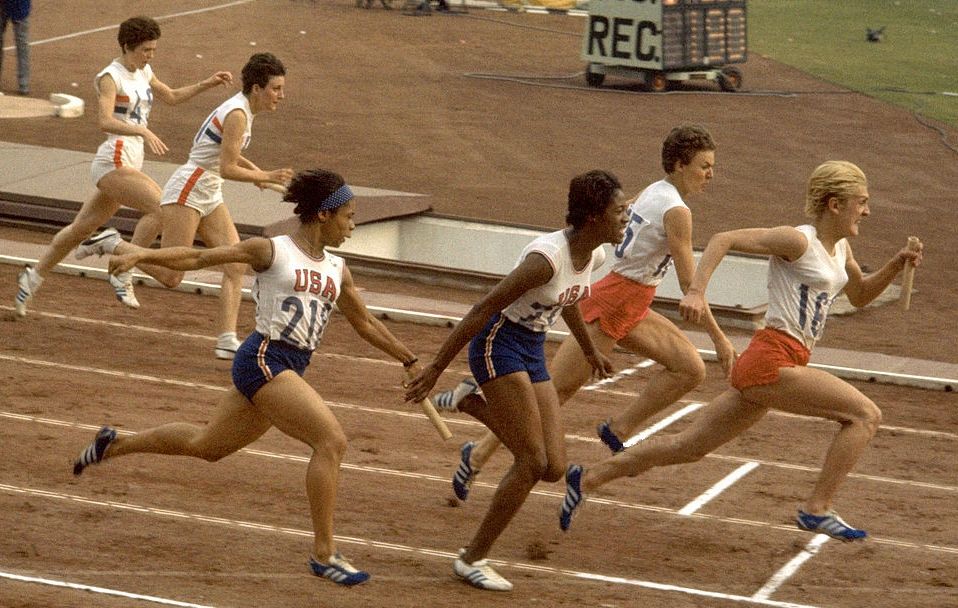This is the first of a three-part series that will explore the history of gender testing in sports and how it affects the modern sporting climate. Part I looks at the early origins of gender testing.
Governing bodies in sports, from minor leagues to major international organizations such as the International Olympic Committee (IOC), have long been free to discriminate on the basis of race, ethnicity, sex, and gender. In particular, sex verification or determination testing has frequently targeted women athletes. Women whose athletic performances defy society's expectations, who are "too good," are expected to prove that they are women. This is especially true for women who, in addition to excelling athletically, also challenge the accepted standards of white feminine beauty. Sex verification testing and classification is typically justified on the basis of "fair play." However, "fair play" is a nebulous term, with its contemporary origins in nineteenth-century organized sport. Today, the term tends to mean competition without unbalanced competitive advantage, but as science historian Vanessa Heggie writes, "There are probably hundreds of genetic variations which lead to 'unfair' advantages in sport; only those associated with gender are used to exclude or disqualify athletes."
Women were first allowed to participate at the Olympics in 1900. Many women's sporting bodies were created in the 1910s and 1920s to increase women's participation in sport. The Women's World Games were a track and field competition held in 1922, 1926, 1930, and 1934 in response to the dearth of events for women at the Olympics. The WWG pushed the Olympic program to expand and include women's track and field events. Increased presence at the Olympics meant increased oversight from cis men for women's sports. The 1936 Summer Olympics in Berlin were a watershed moment for women's competition; a record 331 women participated in the Games (131 more than competed at the 1934 WWG). Unfortunately, sex verification became a prominent issue at the Olympics in Berlin.
Avery Brundage, the fifth IOC president, is mostly remembered for his anti-Semitism, which is shown by his role securing American participation in the Nazi Games of 1936 and for his refusal to "politicize" the Summer Olympics in 1972 after the murder of 11 Israeli athletes during the Games in Munich. In addition to his admiration for Hitler and his anti-Semitism, Brundage was incredibly misogynistic, even by the standards of his time. However, Brundage's public disputes with women athletes like Babe Didrikson and Eleanor Holm have overshadowed his work that more broadly harmed and discredited women athletes.
In 1936 Brundage was president of the United States Olympic Committee, a post he would hold until becoming president of the IOC in the 1950s. At the Berlin Summer Games in 1936, a member of Brundage's team, American sprinter Helen Stephens, edged out Polish favourite Stanislawa Walasiewicz for the gold medal in the women's 100 metre. Stephens' sex was questioned, but after she underwent testing, she was declared the winner. Brundage retaliated by demanding "examination for sex ambiguities in all women competitors" at the next Olympics in 1940 (which wouldn't take place until 1948, due to World War II).
Brundage made this request for two reasons. First, he was a dictatorial misogynist who frequently fought with and demeaned women athletes. Second, he was both intimidated and threatened by two contemporary prominent cases of athletes who competed in women's sports and later transitioned. Mark Weston, the "Devonshire Wonder", was an athlete with intersex traits who was assigned female at birth. He was one of the best British field athletes of his time, winning national championships in shot put on three occasions and the women's international shot put title in 1934. In the spring of 1936, he underwent gender-confirmation surgery, changed his name to Mark, and retired from competition. His story was covered widely in the British media and garnered notice in the United States. At around the same time, Zdenek Koubek, a Czechoslovakian track star who set the women's world record for the 800 metre in 1934, underwent gender-confirmation surgery, changed his name to Zdenek, and also retired from competitive track. That same year, Koubek toured the United States and was interviewed by Time magazine as part of an article on sex fraud at the Berlin Games.
Brundage was not the only advocate for sex testing of women athletes, but he was an influential one. A 1948 Life magazine profile of Brundage stated that "He has always been suspicious of athletic women, and he still is… His suspicion is that some of them –- perhaps even a considerable number –- are really men." The examples provided by Weston and Koubek would have undoubtedly fueled Brundage's bigotry, despite the fact that neither were cis men trying to deceive the sporting world by playing women's sports.
As sport became more organized and codified in the late nineteenth century, women's participation was managed (and sometimes outlawed) because of the belief that sport would lead to the masculinization of women. These concerns continued into the twentieth century when women's participation in sport increased. A woman's athletic success, especially if she did not adhere to western standards of female beauty, helped perpetuate a fear of masculinized women. Brundage and those like him weaponized these fears by demanding sex verification for women athletes.
In this way, sex verification policies were less about fairness and more about articulating and maintaining binary gender norms, in an era when those norms were in flux because of women's increased participation in traditionally masculine activities during the war years. This binary continued to be enforced throughout the twentieth century as a way of cementing the artificial status of men's sports as superior. As Claire F. Sullivan states in her article "Gender Verification and Gender Policies in Elite Sport: Eligibility and 'Fair Play'":
Sex determination has been the persistent criteria chosen to "level the playing field." Sports governing bodies are dealing with society's basic categorization of humans and thus are entangled in attempts to scientifically and medically define what it means to be 'male' and what it means to be "female" for the purposes of sports competition. What has been determined overall, is that there is no universally agreed upon definition that can place all humans into the traditional binary. Yet, the definitions established through the creation of testing and policies have far reaching personal and societal impact. It appears that these governing bodies are being pressured to formulate these policies more likely designed to manage binary gender designations than they are in creating a climate of fair play.
Unfortunately, Brundage got his way, and some of the most controversial sex testing procedures were implemented during his tenure as IOC president. After World War II, sex verification entered mainstream sports, though the standards were informal and not unified. In 1946, the International Amateur Athletics Federation (IAAF, later the International Association of Athletics Federations) required women athletes to submit medical certificates indicating their status as women in order to participate in track and field events; the IOC had the same requirements beginning in 1948, the first Olympics in 12 years. However, the standards used to determine suitable womanhood were not codified by either organization and varied by country.
Yet speculation about the "true sex" of successful women athletes continued. The persistent belief that cis men were participating in women's sports to achieve glory was perpetuated because of an entrenched commitment to maintaining a strict gender binary, as well as political motivations. While women athletes from any national team could, and did, encounter suspicion about their gender, the athletes who received the most attention in Western media tended to be Soviet competitors. Today, most of the athletes who received this attention would be acknowledged as athletes with intersex traits who were assigned female at birth, some of whom later underwent gender transition.
But because the sports world has restrictive definitions of sex and gender, intersex athletes have been frequently persecuted for their athletic achievements. Rather than seek to include intersex and trans athletes in competitive sports, organizations like the IOC implemented new regulations and policy regarding sex and gender. Medical certificates didn't prevent suspicion about several athletes at the Olympics Games held in 1960 and 1964. In response, standardized and at-event verification tests were developed to achieve more "accurate" results. Beginning in 1966 at the European Athletics Championship, women athletes were forced to undergo a visual examination of primary and secondary sex features by a panel of gynecologists. At the 1966 Commonwealth Games, women athletes were forced to undergo "manual examinations" –- sexual assault masquerading as sex verification. At the Pan-Am Games the following year, women athletes were forced to participate in an infamous "naked parade" to determine sex. Women athletes despised these "tests" because they were both intrusive and subjective. Maren Sidler, an American shot putter, recalled the naked parade at the Pan Am Games in 1967: "You had to go in and pull up your shirt and push down your pants. Then they just looked while you waited for them to confer and decide if you were OK. While I was in line I remember one of the sprinters, a tiny, skinny girl, came out shaking her head back and forth saying. 'Well, I failed, I didn't have enough top. They say I can't run and I have to go home because I'm not 'big enough.'"
These tests did not determine anything about supposed athletic advantage. What such testing achieved was to cement rigid and binary understandings of sex and gender difference in sport while harassing and assaulting women competitors. As controversial as it might have been to state at the time, genitalia do not confer sporting advantage. Criticism of the naked parades and advances in scientific caused the IAAF, IOC, and other sporting bodies to turn to more "scientific" methods of determining sex, which ushered in the era of chromosomal testing.
Most athletes with intersex traits and trans athletes "caught" by gender regulations from the 1930s until the 1960s either left their sports willingly or were forced to retire. However, by the late 1960s and with the advent of chromosomal testing, athletes were now formally disqualified and banned for failing sex verification tests. Ewa Klobukowska, a Polish sprinter with intersex traits who was assigned female at birth, had her athletic career ruined by inexact testing and changing gender requirements. Klobukowska, an Olympic champion and world record holder, failed a visual inspection sex verification test at a European Cup event in 1967. She was subjected to further testing, including an early type of chromosomal test, which she also failed because of an intersex condition that granted her an additional chromosome. The IAAF revoked her medals, victories, and her three world records, including the world record she helped to set as part of the 4x100 relay team at the Tokyo Olympics in 1964. These achievements have yet to be reinstated. She was banned from competitive sport at the age of 21.
Had Klobukowska been tested the following year, in 1968, the new Barr body chromosomal test would have cleared her and allowed her to continue her athletic career. The Barr body test determines if a cell has multiple X chromosomes. The Barr body is an inactive X chromosome and any cell with multiple X chromosomes will display as Barr bodies. Athletes possessing at least two X chromosomes were able to compete as women (Klobukowska included); those possessing only one X chromosome would be disqualified.
While the Barr body test would have cleared Klobukowska to compete, this test, and chromosomal testing in general, were still discriminatory. Trans man Erik Schinegger was a world-class Austrian skier with intersex traits who was assigned female at birth. He won the women's downhill world championship at 17 in 1966. Schinegger was a favourite to medal, but was disqualified from participating at the Winter Olympics in Grenoble in 1968 because sex verification testing revealed he had intersex traits. Schinegger underwent gender-confirmation surgery, changed his name to Erik, and trained to make the Austrian men's team for the the 1972 Olympics in Sapporo. He competed on the men's team for a short period before being forced out of the sport by the Austrian Ski Federation because he was transgender.
While the Barr body test was less invasive and subjective than visual inspection sex verification tests, it did not account for the chromosomal variety of humans nor for the existence of trans athletes. In addition, chromosome type is not an accurate measure of athletic ability or sporting advantage. Simply possessing XY chromosomes does not indicate that an individual is a superior athlete. Despite these facts, chromosomal testing was the standard that the IAAF, the IOC, and other sporting bodies used when enforcing gender regulations for more than two decades.
The case of Maria Martínez-Patiño, a Spanish hurdler with an intersex karyotype, helped push mandatory chromosomal testing for women out of elite sport. While competing at the World University Games in 1985, Martínez-Patiño's sex verification test revealed that the track athlete had intersex traits. After the public humiliation of star athletes like Klobukowska and Schinegger in the late 1960s, the IAAF and IOC encouraged athletes who would be disqualified, based on their sex testing results, to fake injury and retire throughout the 1970s and 1980s. These athletes were effectively, if not officially, banned from competing, even though the results of their tests were not publicly revealed. Martínez-Patiño was encouraged to follow this course and initially did so; however, in 1986 she decided to participate in hurdling events at the Spanish national championships. Again, she was threatened with public exposure if she didn't quietly retire. Martínez-Patiño competed anyway and won the 60 metres hurdles title. Her test results were released publicly and Martínez-Patiño was formally banned from competition, eviscerated in the Spanish press, had her medals revoked, and lost her scholarship, athletic residency, and personal relationships. Martínez-Patiño continued to fight her ban, which was finally overturned in 1988. Her ban was overturned because she has androgen insensitivity syndrome, a medical condition that meant she gained no supposed hormonal advantage from the intersex traits that disqualified her from competition.
Martínez-Patiño's case was another example of the failures of chromosomal testing. Her challenge, and the attention it garnered from activists and scientists, helped to push sporting bodies to abandon chromosomal testing of women athletes. In 1988, the same year Martínez-Patiño's ban was overturned, the IAAF eliminated chromosomal testing in favour of a combination of the abusive manual/visual check. This approach, and systematic sex testing more broadly, were abandoned in 1992, but the IAAF maintained the option to test specific women athletes on a case-by-case basis.
Like the IAAF, the IOC realized the limitations of Barr body chromosomal testing in the early 1990s. Instead of acknowledging the discriminatory nature of sex verification testing of women athletes, the IOC endorsed new regulations and testing procedures designed to once again control women, gender-diverse folks, and athletes with intersex traits. In 1992, the IOC introduced a sex verification test that was designed to detect the presence of the SRY gene, usually found on the Y chromosome. Because the SRY gene is involved in male sexual development, including testicular formation, the IOC believed the test better indicated both the sex and gender of women's athletes. Women athletes who tested positive for the SRY gene would therefore be ineligible. However, this test simply perpetuated the problems of the Barr body test with regards to athletes with intersex traits and gender diverse athletes. Possessing the SRY gene was no more an indication of athletic ability and advantage than possessing XY chromosomes. Again, SRY genetic testing revealed if an athlete possessed a certain gene, but could not determine the "fairness" of that athlete competing. At the 1996 Olympics in Atlanta, eight women were flagged by the SRY test, but were still allowed to compete. It wasn't until 1999 that the IOC also abandoned mandatory sex testing for all women athletes.
Sex and gender verification testing of women athletes in the sports world has always been a political tool. Ostensibly implemented to ensure women athletes were able to compete in exclusively women's sports, these policies and regulations were instead used to fight a nonexistent threat. Cis men have never donned disguises in any sort of number that would require any regulatory response from sporting bodies to ensure fair play. But the threat of cis men polluting women's sports was politicized, conventionally depicted as a communist threat, and weaponized against women, gender non-conforming athletes, athletes with intersex traits, and trans athletes. Mandatory sex verification of women athletes was an assault on women's sports; the procedures were sexually abusive, emotionally traumatizing, and publicly humiliating.
Sex verification tests evolved from medical certificates, to naked parades, to chromosomal and genetic testing. Each step in the evolution of such testing was in response to criticism that these tests were not only invasive, but that they failed to determine both womanhood and unfair athletic advantage.
In reality, sex verification tests were never about ensuring "fair play" in women's elite sports. Rather, sex verification tests were about ensuring and promoting a binary understanding of sex and gender (the persecution of athletes with intersex traits and trans athletes during the twentieth century illustrates this). This binary understanding marks women's sports as lesser, and therefore, in need of special protections, while simultaneously securing undeserved advantages for cis men's sports.
Part II of this series will examine the evolution of sex and gender testing in the twenty-first century.
(Photo credit: Wikimedia Commons)







